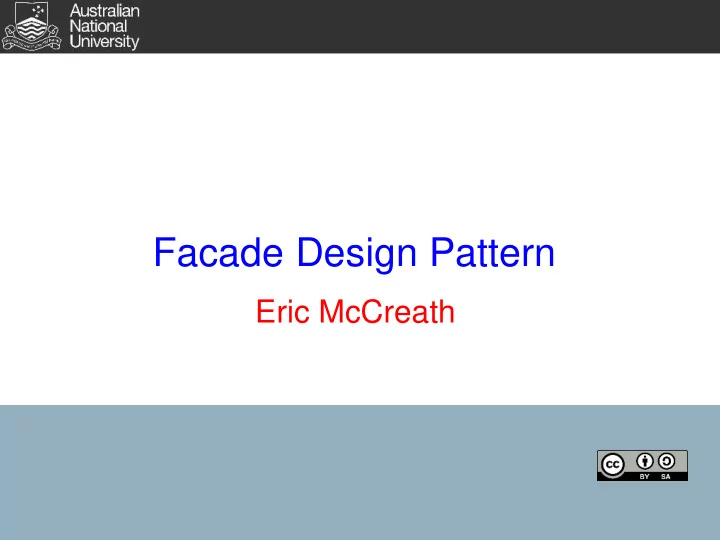

Facade Design Pattern Eric McCreath
Overview In this lecture we will: define the facade design pattern, review a simple example, discuss when the facade is useful, and provide some examples of using this design pattern. 2
Definition The facade design pattern uses a class to provide a simplified Application Programming Interface (API) to a complex module (such as a collection of classes or a library). Without the Facade The Facade "Funnels" the code would directly the access to the library. access the library. Library Library Facade Your code Your code Code Code 3
Simple Example Say a program you are developing wishes to load and save small text files. This could be achieved by directly accessing the standard java.io package. However, java.io is large and somewhat complex, thus one may create a Facade class for this loading and saving of a file. Part of this code is shown below (the full listing is available in the example code repo). public class LoadSaveFacade { static String load(String filename) { : : } static boolean save(String filename, String text) { : : } } So now the rest of your code will use the "load" and "save" methods, rather than the java.io package. 4
Advantages and Disadvantages Advantages of the facade design pattern include: simplifies the use of a complex library/collection of classes, concentrates the code for that library/collection of classes into one point in your code, and reduces the coupling between your code and the library/collection of classes. Disadvantages include: adds a layer of indirection which may affect performance, may make your code base bigger, and your developers will need to learn to use this bespoke API (whereas they may be very familiar with the library). 5
Other Examples There are many situations this design pattern may be used. These include; access to a database, access to io devices (e.g. webcam, sound card), file io, using visualization libraries, network communication, using machine learning libraries, using computer vision libraries ...... 6
Example Exam Questions Explain the Facade design pattern. Illustrate this with an example of when using the Facade design pattern would be useful. The "PassTheMessage" project available at: git@gitlab.cecs.anu.edu.au:u4033585/passthemessage.git has 4 classes. Would you describe any of them as being a "Facade"? If yes, explain why. If not, explain why not. The java.lang.Boolean class provides a simple class for storing booleans. It also provides some basic methods for operating on booleans. Would it be a good idea to construct a Facade class for the Boolean class? Explain. 7
Recommend
More recommend